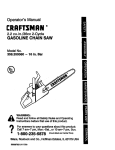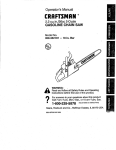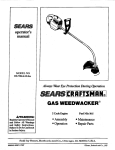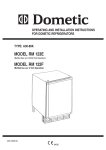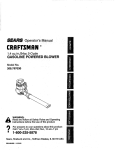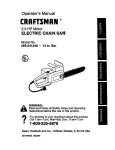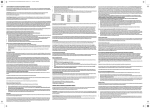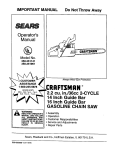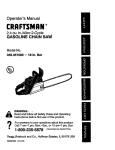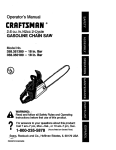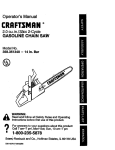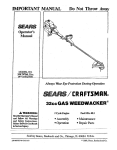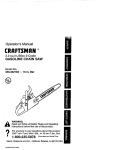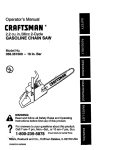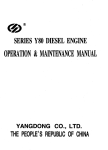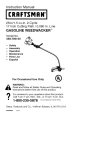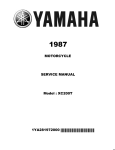Download Craftsman 358.350160 Operator`s manual
Transcript
Operator's Manual
CRAFTSMRN
2.2 cu. in ./36cc 2-Cycle
GASOLINE CHAIN SAW
Model No.
358.350160 -- 16 in. Bar
@
Read and follow all Safety Rules and Operating
WARNING:
Instructions before first use of this product.
For
to your
questionsor about
this pm,
product:
Call answers
7 am-7 pro,
Mon.-Sat.,
10 am-7
Sun.
•
1"800-235-5878
(Hourslisted are Central Time)
Sears, Roebuck and Co., Hoffman Estates, IL 60179 USA
530087755 1/11/99
Warranty
Safety Rules
Assembly
Operation
Maintenance
Service and Adjustments
2
2
5
6
11
14
Storage
Trouble Shooting Chart
Parts List
Spanish
Parts & Ordering
16
17
20
24
Back
FULL ONE YEAR WARRANTY ON CRAFTSMAN ® GAS
CHAIN SAW
For one year from the date of purchase, when this Craftsman Gas Chain Saw is
malntai0ed, lubdcated and tuned up according to the owner's manual, Sears will
repalr_free of charge, any defect in material or workmanship.
This Warranty excludes the bar, chain, spark plug and air filter, which are
expendable parts, and become worn during normal use.
If this Gas Chain Saw is used for commercial or rental purposes, this warranty
applies for 30 days from the date of purchase.
WARRANTY SERVICE IS AVAILABLE BY RETURNING THIS CHAIN SAW TO
THE NEAREST SEARS SERVICE CENTER IN THE UNITED STATES.
This warranty gives you specific legal dghts, and you may also have other dghts
which vary from state to state.
Sears, Roebuck and Co., D/817 WA, Hoffman Estates, IL 60179
WARNING: Always disconnect spark
plugwire when making repairs except
for carburetor adjustments. Because a
chain saw is a high-speed woodcutting
tool, careless or improper use of this
tool can cause serious injury.
PLAN AHEAD
• Restrict the use of your saw to adult
users who understand and can follow
the safety rules, precautions, and operating instructionsfound.in this
manual.
duty, non-slip gloves; eye protection
such as non-fogging, vented goggles
or face screen; an approved safety
hard hat; and sound barriers (ear
plugs or mufflers) to protect your
hearing. Regular users should have
hearing checked regularly as chain
saw noise can damage headng. Secure hair above shoulder length.
° Keep all parts of your body away from
the chain when the engine is running.
• Keep children, bystanders, and animals at least 30 feat (10 meters)
Hearing
_ _
Safety Hat
away from the work area when startProtection_ __
Eye
ing and usingthe saw.
Snug
_=wet---- Protection
Do not handle or operate a chain saw
F_ng "--_J
Heavy Duty
when you are fatigued, ill, or upset, or
_,oming
_
. Gloves
if you have taken alcohol, drugs, or
medication. You must be in good
physicalcondition and mentally alert.
If you have any condition that might
be aggravated by strenuous work,
check with doctor before operating.
Do not start cuffing untilyou have a
• Wear protective gear. Always use
clear work area, secure foob'ng,and
etesl-toed safety footwear with nonespecially if you are felling a tree, a
slip soles; snug-firing clothing; heavy- retreat path.
2
• Store the unit and fuel in a cool, dry
OPERATE YOUR SAW SAFELY
well ventilated space where fuel va• Do not operatewith onehand.Seripors cannot reach sparks or open
ous injuryto the operator,helpers,or
flames
from water heaters, electric
bystandersmay resultfrom onemotors
or switches, furnaces, etc.
handedoperation.A chain sawis intendedfor two-handeduse.
GUARD AGAINST KICKBACK
• Operatethe chain saw only in a well- Follow all safety rules to help avoid
ventilated outdoor area.
• Do not operate saw from a ladder or
in a tree, unless you are specifically
trained to do so.
• Make sure the chain will not make
contact with any object while starting
the engine. Never try to start the saw
when the guide bar is in a cut.
• Do not put pressure on the saw, especially at the end of the cut. Doing
so can cause you to lose control
when the cut is completed.
• Stop engine before setting saw down.
• Hand carry saw only when engine is
stopped. Carry with muffler away from
body; guide bar & chain projecting behind you; guide bar preferably covered with a scabbard.
kickback and other forces which can
result in sedous injury.
'_
_
Kickback Path
Avoid Obstructions
ClearThe Working Area
WARNING: Rotational Kickback can
occur when the moving chain contacts
an object at the upper portion of the tip
MAINTAIN YOUR SAW IN GOOD
of the guide bar. Contact at the upper
WORKING ORDER
portion of the tip of the guide bar can
• Have all chain saw service performed cause the chain to dig into the object,
which stops the chain for an instant. The
by a qualified service dealer except
the items listed in the maintenance
result is a lightning fast, reverse reaction
section of this manual.
which kicks the guide bar up and back
toward the operator.
• Make certain the saw chain stops
moving when the throttle trigger is re- Pinch-Kickback and Pull-in occur when
leased. For correction, refer to "Carthe chain is suddenly stopped by being
buretor Adjustments."
pinched, caught, or by contacting a for• Keep the handles dry, clean, and free eign object in the wood. This sudden
from oil or fuel mixture.
stopping of the chain results in a rever• Keep caps and fasteners securely
sal of the chain force used to cut wood
and causes the saw to move in the optightened.
• Use only Craftsman accessodas and posite direction of the chain rotation.
replacement parts as recommended.
Pinch-Kickback drives the saw straight
Never modify your saw.
back toward the operator. Pull-In pulls
the saw away from the operator.
HANDLE FUEL WITH CAUTION
REDUCE THE CHANCE OF
• Do not smoke while handling fuel or
KICKBACK
while operating the saw.
• Eliminate all sources of sparks or flame • Recognize that kickbackcan happen.
With a basic understandingof Idckback,
in areas where fuel is mixed or poured.
you can reduce the element of surpdse
• Mix and pour fuel in an outdoor area
which contributesto accidents.
and use an approved, marked conNever !at the moving chain contact
tainer for all fuel purposes. Wipe up
_any object at the Up of the guide bar.
all fuel spills before starting saw.
Keep working area free from obstruc• Move at least 10 feet (3 meters) from
tions such as other trees, branches,
fueling site before starting.
rocks, fences, stumps, etc. Eliminate
• Turn the engine off and let saw cool in or avoid any obstruction that your saw
a non-combustible area, not on dry
chain could hRwhile cutting.
leaves, straw, paper, etc. Slowly re• Kee? saw chain sharp and properly
tanmoned. A loose or dull chain can
move fuel cap and refuel unit.
3
increasethe chanceof kickback.Followmanufacturer'schainsharpening
and maintenance instructions. Check
tension at regular intervals, but never
with engine running. Make sure bar
clamp nuts are securely tightened.
• Begin and continue cutting at full
speed. If the chain is moving at a
slower speed, there is greater chance
of kickback occurring.
• Use extreme caution when reentering
a cut.
• Do not attempt cuts starting with the
tip of the bar(plunge cuts).
• Watch for shifting logs or other forces
that could close a cut and pinch or fall
into chain.
• Use the specified Reduced-Kickback
Guide Bar and Low-Kickback Chain,
Avoid Pinch-Kickback:
• Be extremely aware of situations or
obstructions that can cause material
to pinch the top of or otherwise stop
the chain.
• Do not cut more than one log at a
time.
• Do not twist saw as bar is withdrawn
from an undercut when bucking.
Avoid Pull-in:
• Always begin cutting with the engine
at full speed and the saw housing
against wood.
• Use wedges made of plastic or wood.
Never use metal to hold the cut open.
MAINTAIN CONTROL
Stand to the left of the saw
keep your body from being in a direct
line with the cutting chain.
• Stand with your weight evenly balanced on both feet.
• Do not overreach. You could be drawn
or thrown off balance and lose control.
• Do not cut above shoulder height. It is
difficult to maintain control of saw
above shoulder height,
KICKBACK SAFETY FEATURES
WARNING: The following features are
included on your saw to help reduce
hazard of kickback; however, such features will not totally eliminate this danger. Do not rely only on safety devices.
• Handguard: designed to reduce the
chance of your left hand contacting
the chain if your hand slips off the
front handlebar.
• Position of front and rear handlebars:
designed with distance between handles and =in-line" with each other. The
spread and "in-line" position of the
hands provided by this design work
together to give balance and resistance in controllingthe pivot of the
saw back toward the operator if kickback occurs.
• Reduced-Kickback Guide Bar: designed with a small radius tip which
reduces the size of the kickback danger zone. This type bar has been
demonstrated to significantly reduce
the number and seriousness of kickbacks when tested in accordance with
ANSI B175.1.
Small Redius
Tip Guide Bar
of handleba=
\!
Thumbon
underside_
Elbow
locked
• Low-KickbackChain: has met kickback
performance requirements when tested
Never reversehand positions
on a representative sample of chain
• A good, firm onp
• on the saw with
• both saws
below 3 "8 cubic
inch
....
.............
hands w=llhel'o
'
•
•
oksplacemen_specmea
m Areal U] (_ •] •
you maJntam control...........
.
LOW F_ICKDSCK _n_,n
Don_t let go. _rlp the rear handle with
"
your right hand whether you are right
_
ContouredDepth Gauge
or left handed. Wrap the fingers of
_-Elongated GuardUnk
your left hand over and around the
_--_"P"DeflectsKickback
front handlebar, and your left thumb
'L_
_
Farce AndAllows
under the front ha_..dlebar.Keep your
_
_k5
WoodTo Gradually
left _
straight with the elbow locked. _
Ride IntoCutter
• Pos=tlonyour !.e.Rhand on the front
SAFETY NOTICE: Exposure to
handlebar so it =sin a straight line withvibrafions through prolonged use of
your fight hand on the rear handle
gasoline powered hand tools could
when making bucking cuts. Stand
cause blood vessel or nerve damage in
slightly to the left side of the saw to
the fingers, hands, and joints of people
4
muffler and spark arresting screen
which meets the requirements of
cold weather has been linked to blood
California Codes 4442 and 4443. All
vessel damage in otherwise healthy
U.S. forest land and the states of
people. If symptoms occur such as
California, Idaho, Maine, Minnesota,
numbness, pare, loss of strength,
New Jersey, Oregon, and Washington
change in skin color or texture, or loss require by law that many internal
of feeling in the fingers, hands, or joints, combustion engines be equipped with a
discontinue the use of this tool and
spark arrestor screen. If you operate a
seek medical attention. An
chain saw in a state or locale where
anti-vibration system does not
such regulations exist, you are legally
guarantee the avoidance of these
responsible for maintaining the
problems. Users who operate power
operating condition of these parts.
tools on a continual and regular basis
Failure to do so is a violation of the law.
must closely monitor their physical
condition and the condition of this tool. Refer to Customer Responsibilities
CHAIN BRAKE If this saw is to be u_sbd chart in the k_AtWi'ENANCEsection.
for commercial logging, you must order STANDARDS: This chain saw is listed
and install a chain brake to comply with by Underwriters Laboratories, Inc. in
accordance with American National
Federal OSHA Regulations for ComStandards for Gasoline-Powered Chain
mercial Logging. Contact your Sears
Service Center or call 1-800-235-5878.
Saws Safety Requirements (ANSI
SPARK ARRESTOR: Your saw is
B175.1-1991).
equipped with a temperature limiting
proneto circulationdisordersor
abnormalswelling. Prolonged use in
CARTON CONTENTS
Check carton contents against the following list.
Model 358.350160
• Chain Saw (fully assembled)
• Bar tool
• 2-cycle engine oil
• Log Carder
• Carrying Case
• Examine parts for damage. Do not
use damaged parts.
• If you need assistance or find that
parts are missing or damaged, please
call 1-800-235-5878.
NOTE: It is normal to hear the fuel filter
raffle in an empty fuel tank.
Your unit has been factory tested and
the carburetor precisely adjusted. As a
result you may smell gasoline or find a
drop of oil/fuel residue on the muffler
when you unpack the unit.
ASSEMBLY
Your saw is fully assembled; no
assembly is necessary.
5
KNOW YOUR SAW
READTHIS OPERATOR'SMANUALANDSAFETYRULESBEFOREOPERATINGYOURCHAINSAW.Comparethe illustrationswith your unitto familiarize
yourseffwith the location of the various controls and adjustments. Save this
manual for future reference.
• ,_.....
iu_
"
,u_,
,-"=
Chain
.
_
FrontHandle
HandGuara.--.b_
Muffler"'"='1
/
Bar Oil Fill Cap
y
t_
_
Starter
HousJn
Start, Rope
g o=o,
_'_ _J/_
Primer
/
Fuel Mix Fill Cap
Cylinder Cover
Throttle Look
Lockout
Adjusting
Screw
Rear
Handle
Throttle
Tdgger
Chain
Direction
of Travel
Choke
Bar Clamp Nuts Guide Bar
Knob Bar Clamp Chain
Catcher
ON/STOP SWITCH
The ON/STOP Switch is used to stop
the engine.
THROTTLE TRIGGER
The throttle trigger controls engine
speed.
THROTTLE LOCKOUT
The throttle lockout must be pressed
before you can squeeze the throttle trigger. Thin feature prevents you from accidentally squeezing the trigger.
FAST IDLE LOCK
The fast idle lock holds the throttle trigger in the starting position. Activate the
fast idle lock by pressing the throttle
lockout and squeezing the throttle trigger. With the throttle trigger squeezed,
press the fast idle lock. Release the
throttle lockout and trigger while holding
the fast idle lock button.
CHOKE KNOB
The Choke Knob activates the choke to
provide additional fuel to the engine
during cold starting.
PRIMER BULB
The Primer Bulb circulates fuel to the
carburetor to provide quicker starting.
CHAIN TENSION
It is normal for a new chain to stretch
during first 30 minutes of operation. You
should check your chain tension frequently. See Chain Tension under the
Service and Adjustments section.
6
lines and carburetorare empty. Use fresh
fuel next season. See STORAGEinstrucWARNING: Be sure to read the fuel
tions for additional information.
handling in._.rmation in the safety rules Never use engine or carburetor cleaner
section of th,s manual before you begln. products in the fuel tank or permanent
If you do not understand the fuel handamage may occur.
dling information do not attempt to fuel See the STORAGE section for additional
your unit. Seek help from someone that information.
does understand the information or call
STOPPING YOUR ENGINE
the customer assistance help line at
• Move On/Stop switch to STOP.
1-800-235-5878.
• If engine does not stop, pull choke
GUIDE BAR AND CHAIN OIL
knob out fully.
The chain oiler provides continuous lu- STARTING YOUR ENGINE
brication to the chain and guide bar. Be
sure to fill the bar oil tank when you fill COLD ENGINE OR WARM ENGINE
AFTER RUNNING OUT OF FUEL
the fuel tank (Capacity = 6.8 ft. oz.).
For maximum guide bar and chain life, • Fuel engine with 40:1 fuel mix.
• Fill bar oil tank with bar oil.
we recommend you use Craftsman
chain saw bar oil. if Craftsman bar oil is • Prime engine by pressing pdmer bulb
six times.
not available, you may use a good
•
Move On/Stop switch to ON.
grade SAlE30 oil until you are able to
Primer Bulb
obtain Craftsman brand. The oil output
is automatically metered during operation. Your saw will use approximately
one tank of bar oil for every tank of fuel
mix. Always fill the bar oil tank when
you fill the fuel tank.
BEFORE STARTING ENGINE
FUELING ENGINE
Choke Posl_ons
This engine is certified to operate on
unleaded gasoline. Before operation,
gasoline must be mixed with a good
•1/I//
4._ lqI[_
Off Full
quality 2-cycle air-cooled engine oil. We
recommend Craftsman brand oil. Mix
• Actuate choke by pulling choke knob
fully out.
gasoline and oil at a ratio of 40:1 (A
• Set saw on the ground, Grip front
40:1 ratio is obtained by mixing 3.2
handle with your left hand and place
ounces of oil with 1 gallon of unleaded
right foot through rear handle.
gasoline). DO NOT USE automotive oil
or boat oil. These oils will cause engine
Starter Rope Handle
damage. When mixing fuel follow the
instructions printed on the container.
Once oil is added to the gasoline,
Left Hand
shake container momentarily to assure
on Front
that the fuel is thoroughly mixed.
Handle
Always read and follow the safety rules
relating to fuel before fueling your unit.
t
I
IMPORTANT
Experience indicatesthat alcohol blended
Foot Through Rear Handle
fuels (called gasohol or using ethanol or
• Set fast idle by depressing the throttle
methanol) can at_act moisturewhich
lock with your dght hand. Then,
leads to separation and formationof
squeeze and hold throttle trigger. With
acids dudng storage. Acidicgas can
your thumb, press the fast idle lock '
damage the fuel system of an engine
down and hold. Next, release the
while in storage.
throttle trigger.
To avoid engine problems,the fuel system should be emptied before storagefor • DONOT squeeze throttle trigger during starting; otherwise, it will be nec30 days or longer. Drain the gas tank,
essary to reset the fast idle lock.
start the engine and let it run untilthe fuel
7
NOTE:When pullingthe starterrope,
do not usethe full extentof the rope.
Do not let starter rope snap back. Hold
handle. Let rope rewind slowly.
• Pull starter rope handle firmly and
quickly with your right hand until the
engine attempts to start, but no more
than 5 pulls. Then, push in choke
knob to the fulll position. Resume pulling handle until engine starts.
• Above 40°F, allow engine to run for
approximately 5 seconds. Push the
choke knob in to the OFF position;
then squeeze and release throttle trigger to allow engine to idle.
• Below 40°F, allow engine to warm up
for 30 seconds to I minute with choke
at approximatily 1/2 position. Push
choke knob in to the OFF position;
then squeeze and release throttle trigger to allow engine to idle.
• To stop engine, move On/Stop switch
to the STOP position.
OPERATING
TIPS
• Check chain tension before first use
and after I minute of operation. See
Chain Tension in the Maintenance
section.
• Cut wood only. Do not cut metal, plastics, masonry, non-wood building materials, etc.
• Stop the saw if the chain strikes a foreign object. Inspect the saw and repair parts as necessary.
• Keep the chain out of dirt and sand.
Even a small amount of dirt will quickly dull a chain and increase the possibility of kickback.
• Practice cutting a few small logs using
the following steps. This will help you
get the =feel" of using your saw before
you begin a major sawing operation.
• Squeeze the throttle trigger and allow the engine to reach full speed
before cutting.
• Begin cutting with the saw frame
against the log.
• Keep the engine at full speed the
entire time you are cuffing.
• Allow the chain to cut for you. Exert
only light downward pressure.
• Release the throttle trigger as soon
as the cut is completed, allowing the
engine to idle. If you run the saw at
full throttle without a cutting load,
unnecessary wear can occur.
• To avoid losing control when cut is
complete, do not put pressure on
saw at end of cut.
• Stop engine before setting saw down.
STARTING A WARM ENGINE
DO NOT use the choke to start a warm
engine or flooding and hard starting
may occur.
• Move On/Stop switch to ON.
• Set fast idle lock.
• Be sure choke is in the OFF position.
• With saw on ground, grip front handle
with left hand and place your right foot
through rear handle.
• Pull starter rope handle until engine
starts.
• Squeeze and release throttle trigger
to return engine to idle speed.
TREE FELLING TECHNIQUES
WARNING: Check for broken or dead
DIFFICULT STARTING OR
STARTING A FLOODED
ENGINE
branches which can fall while cutting
The engine may be flooded if it has not causing serious injury. Do not cut near
started after 10 pulls. Flooded engines buildings or electrical wires if you do not
can be cleared of excess fuel with the
know the direction of tree fall, nor cut at
night since you will not be able to see
following procedure:
well, nor during bad weather such as
• Engage the fast idle lock.
• Verify that the On/Stop switch is in the rain, snow, or strong winds, etc.
ON position.
• Carefully plan your sawing operation
in advance.
• Push choke knob to the OFF position.
•
Clear the work area. You need a clear
• With saw on ground, grip front handle
with left hand and place right foot
area all around the tree so you can
through rear handle.
have secure footing.
• Pull starter rope handle until engine
• Study the natural conditions that can
starts.
cause the tree to fall in a particular
direction. These conditions include:
• Starting could require many pulls depending on how badly the unit Is
• The wind direction and speed.
• The lean of the tree. The lean of a
flooded. If engine still fails to start, refer to the TROUBLESHOOTINGchart or
tree might not be apparent due to
call 1-800-235-5878.
uneven or sloping terrain. Use a
8
plumbor level to determinethe directionoftree lean.
This hinge will help prevent the tree
from falling in the wrong direction.
• Weight and branches on one side.
Hinge holds tree on
• Surrounding trees and obstacles.
stump and helps
control fail
• Look for decay and rot. If the trunk is
rotted, it can snap and fall toward the
Opening of
operator.
felling cut
• Make sure there is enough room for
the tree to fall. Maintain a distance of
2-1/2 tree lengths from the nearest
person or other objects. Engine noise
can drown out a warning call.
NOTE: Before felling cut is complete,
• Remove dirt, stones, loose bark,
use wedges to open the cut when
nails, staples, and wire from the tree
necessar,/to control the direction of fall.
where cuts are to be made.
To avoidklckback and chain damage,
use wood or plastic wedges, but never
steel or iron wedges.
Plan a clearretreatpath
• Be alert to signs that the tree is ready
to fall: cracking sounds, widening of
the felling cut, or movement in the up;_.... L ._--'m'_ - Direction of Fall
per branches.
• As tree starts to fall, stop saw, put it
down, and get away quickly on your
planned retreat path.
FELLING LARGE TREES
• Be extremely cautious with partially
(6 inches in diameter or larger)
fallen trees that may be poody supported. When a tree doesn't fall comThe notch method is used to fell large
pletely, set the saw aside and pull
trees. A notch is cut on the side of the
down the tree with a cable winch,
tree in the desired direction of fall. After
block and tackle, or tractor. Do not
a felling cut is made on theopposite
use your sawto cut down a partially
side of tree, the tree will tend to fall in
fallen tree.
the direction of the notch.
NOTE: If tree has large buttress roots,
remove them before making the notch.
NOTCH CUT AND FELLING TREE
• Make notch cut by cuffing the top of
the notch first. CUt through 1/3 of the
diameter of the tree. Next complete
the notch by cutting the bottom. See
illustration. Once the notch is cut, remove the wedge of wood from tree.
Finalcuthere
Firstcut
CUTTING A FALLEN TREE
(BUCKING)
Bucking is the term used for cutting a
fallen tree to the desired log size.
WARNING: Do not stand on the log
being cut. Any portion can roll causing
loss of footing and control. Do not stand
downhill of the log being cut.
IMPORTANT POINTS
• Cut only one log at a time.
• Cut shattered wood very carefully;
sharp pieces of wood could be flung
toward operator.
• Use a sawhorse to cut small logs.
Never allow another person to hold
the log while cutting and never hold
the logwith your leg or foot.
Hinge
• Do not cut in an area where logs,
limbs, and roots are tangled. Drag logs
into a clear area before cuttingthem.
• After removing the wood, make the
BUCKING TECHNIQUES
falling cut on the opposite side of the
WARNING: If saw becomes pinched
notch. This is done by making a cut
about two inches higher than the cen- or hung in a log, don_ttry to force it out.
ter of the notch. This will leave
You can lose control of the saw resultenough uncut wood between the felt- ing in injury and/or damage to the saw.
ing cut and the notch to form a hinge. Stop the saw, drive a wedge of plastic
9
or woodintothe cutuntilthe saw can be
L_,;_ ,_ log
removed easily. Restart saw and carefully for support
reenter the cut. Do not use a metal
wedge. Do not attemptto restartyour
saw when it is pinchedor hung in a log.
Use a wedge to remove pinched saw
_ 2nd Cut ,,_
_st
Cut
I st Cut
Turn saw OFF and use a plastic or
wooden wedge to force cut open.
Overcutting begins on the top side of
the log with the bottom of the saw
against the log. When overcuffing use
light downward pressure.
Overcutting
Undercutting
Undercutting involves cutting on the
underside of the log with top of saw
against the log. When undercutting use
light upward pressure. Hold saw firmly
and maintain control. The saw will tend
to push back toward you.
WARNING: Never turn saw upside
down to undercut, The saw cannot be
controlled in this position.
Always make your first cut on the
compression side of the log,
2nd Cut _
BUCKING USING A LOG OR
SUPPORT STAND
• Remember your first cut is always on
the compression side of the log. (Refer to the illustration below for your
first and second cut).
• Your first cut should extend 1/3 of the
diameter of the log,
• Finish with your second cut.
Using/_
ndCut
_
_Y/:x'''"_/_"
"" 1st Cut
2 nd (
First cut on compassion side of log
#
Second cut
First cut on compression slde of log
BUCKING WITHOUT A SUPPORT
• Overcut through 1/3 of the diameter of
the log.
• Roll the log over and finish with a second overcut.
• Watch for logs with a compresion
side. See illustration above for cutting
logs with a compression side.
LIMBING AND PRUNING
WARNING: Never climb into a tree to
limb or prune, Do not stand on ladders,
platforms, a log, or in any position
which can cause you to lose your balance or control of the saw.
IMPORTANT POINTS
• Watch out for springpoles.
Springpoles are small size limbs
which can whip toward you, or pull
you off balance, Use extreme caution
when cuffing small size limbs.
• Be alert for springback, Watch out for
branches that are bent or under pressure. Avoid being struck by the
branch or the saw when the tension in
the wood fibers is released.
• Frequently clear branches out of the
way to avoid tripping over them.
10
LIMBING
• Limb a tree only after it is cut down.
• Leave the larger limbs underneath the
felled tree to support the tree as you
work.
• Start at the base of the felled tree and
work toward the top, cutting branches
and limbs. Remove small limbs with
one cut.
• Keep the tree between you and the
chain.
• Remove larger, supporting branches
with the 1/3, 2/3 cutting techniques described in the bucking section.
• Always use an overcut to cut small
and freely hanging limbs. Undercutting could cause limbs to fall and
pinch the saw.
branches are higher than your shoulder. Get a professional to do the job.
• Make your first cut 1/3 of the way
through the bottom of the limb.
• Next make a second cut all the way
through the limb.
• Finish the pruning operation by using
an overcut so that the stump of the
limb protrudes 1 to 2 inches from the
trunk of the tree.
ISecond_
First cut
1/3 of way
PRUNING
3rd cut I to 2 in.
from trunk of tree
WARNING:
Limit pruning to limbs
shoulder height or below. Do not cut if
CUSTOMER RESPONSIBILITIES
Fill in dates as you complete
regular service
Before After Every Every
I Yearly Service
Dates
Use Use 5 hrs. 25 hrs_
Check for damaged/worn parts
v"
Check for loose fasteners/parts
_,
Check chain tension
P"
Check chain sharpness
P"
Check guide bar
Clean unit & labels
_,,
Clean air filter
_,
Clean/inspect spark arrestor
screen & inspect muffler
P"
Replace spark plug
GENERAL
RECOMMENDATIONS
The warranty on this unit does not cover items that have been subjected to
operator abuse or negligence. To receive full value from the warranty, the
operator must maintain unit as instructed in this manual. Various adjustments
will need to be made periodically to
properly maintain your unit.
• Once a year, replace the spark plug,
air filter element, and check guide bar
and chain for wear. A new spark plug
and air filter element assures proper
air-fuel mixture and helps your engine
_'
run better and last longer.
WARNING: Disconnect the spark plug
before performing maintenance except
for carburetor adjustments.
LUBRICATION
1 Bar
Sprocket
2 Bar Oil
Fill
Cap
1 Use sprocket lubrication
2 Use Craftsman chain saw bar oil
11
CHECK FOR DAMAGED
OR
WORN PARTS
Replacement of damaged/_wom parts
should be referred to your Sears Service Center.
NOTE: It is normal for a small amount
of oil to appear under the saw after engine stops. Do not confuse this with a
leaking oil tank.
• On/Stop Switch - Ensure On/Stop
switch functions properly by moving
the switch to the =Stop" position.
Make sure engine stops; then restart
engine and continue.
• Fuel Tank - Do not use saw if fuel
tank shows signs of damage or leaks.
• Oil Tank - Do not use saw if oil tank
shows signs of damage or leaks.
CHECK FOR LOOSE
FASTENERS
AND PARTS
• Bar Clamp Nut
• Chain
• Muffler
• Cylinder Shield
• Air Filter
• Clutch Drum/Sprocket
• Handle Screws
• Vibration Mounts
• Starter Housing
• Handguard
CHECK CHAIN TENSION
• Use the screwdriver end of the bar
tool to move chain around guide bar
to ensure kinks do not exist. The
chain should rotate freely.
• Using bar tool, roll chain around guide
bar to ensure all linksare in bar groove.
• Lift up tip of guide bar to check for
sag. Release tip of guide bar, then
turn adjusting screw until sag does
not exist.
• While lifting tip of guide bar, tighten
bar clamp nuts with the bar tool.
Torque to 10-15 ft-lbs.
• Use the screwdriver end of the bar
tool to move chain around guide bar.
• If chain does not rotate, it is too tight.
Slightly loosen bar clamp nuts and
loosen chain by tuming the adjusting
screw. Retighten bar clamp nuts.
• If chain is too loose, it will sag below
the guide bar. DO NOT operate the
saw if the chain is loose.
CHECK CHAIN SHARPNESS
A sharp chain makes wood chips. A
dull chain makes a sawdust powder
and cuts slowly,
CHAIN SHARPENING
Chain sharpening requires special
tools. You can purchase sharpening
tools at Sears or go to a professional
chain sharpener.
CHECK GUIDE BAR
Conditions which require guide bar
maintenance:
• Saw cuts to one side or at an angle.
• Saw has to be forced through the cut.
• Inadequate supply of oil to bar/chain.
Check the condition of guide bar each
time chain is sharpened. A worn guide
bar will damage the chain and make
Bar Tool
cutting difficult. To maintain guide bar:
Bar Clamp Nuts
• Move On/Stop switch to =Stop.n
• Remove bar and chain from saw.
• Loosen bar clamp nuts until they are
• Clean all sawdust and any other
finger tight against the bar clamp.
debris from the guide bar groove and
• Turn adjusting screw until chain baresprocket hole after each use.
ly touches the bottom of guide bar.
Remove Sawdust From
IJ
J_..
Guide Bar Groov_
_i_
12
Sprocket Hole,
INSPECT MUFFLER AND SPARK
ARRESTOR SCREEN
• Burring of guide bar rails is a normal
As the unit is used, carbon deposits
process of rail wear. Remove these
build up on the muffÊerand spark
burrs with a flat file.
arrestor screen, and must be removed
• When rail top is uneven, use a fiat file to avoid creating a fire hazard or affectto restore square edges and sides.
ing engine performance.
Replace the spark arrestor screen if
breaks occur.
• Add lubricant to sprocket hole after
each use.
File
sides
Edges
Square
and
Worn Groove
Muffler Diffuser
Spark
Arrestor
Screen
Correct Groove
Replace guide bar when the groove is
worn, the guide bar is bent or cracked,
or when excess heating or burring of
the rails occurs. If replacement is necessary, use only the guide bar specified
for your saw in the repair parts list or on
the decal located on the chain saw.
CLEAN UNIT & LABELS
• Clean the unit using a damp cloth with
a mild detergent.
• Wipe off unit with a clean dry cloth.
CLEAN AIR FILTER
A dirty air filter decreases the life and
performance of the engine and increases fuel consumption and harmful
emissions. Always clean your air filter
after 15 tanks of fuel or 5 hours of operation, whichever comes first. Clean
more frequently in dusty conditions. A
used air filter can never be completely
cleaned. It is advisable to replace your
air filter with a new one after every 50
hours of operation, or annually, whichever comes first. To clean filter:
• Loosen 3 screws on cylinder cover.
• Remove cylinder cover.
• Remove air filter.
• Clean the air filter using hot soapy
water. Rinse with clean cool water.
Air dry completely before reinstalling.
• Lightly oil air filter before installing to
improve the efficiency of air filter. Use
2-cycle engine oil or motor oil (SAE
30). Squeeze excess oil from filter.
• Reinstall air filter.
• Reinstall cylinder cover and 3 screws
(15-20 in-lbs.).
Air Filter
Cylinder Cover
Screws
Cylinder
Cover
Muffler
Cover
/
Muffler
Body
Muffler Cover
CLEANING THE SPARK
ARRESTOR
SCREEN
Cleaning is required every 25 hours of
operation or annually, whichever comes
first.
• Loosen and remove the 2 muffler cover screws.
• Remove the muffler cover (cover
snaps off muffler body).
• Remove muffler diffuser and spark
arrestor screen assembly. Notice the
orientation of these parts for reassembling.
• Clean the spark arrestor screen with a
wire brush. Replace screen if breaks
are found.
• Replace any broken or cracked muffler parts.
• Reinstall diffuser and spark arrestor
screen assembly with round holes
facing up.
• Reinstall muffler cover and 2 screws
(7-8 ft-lbs).
REPLACE SPARK PLUG
The spark plug should be replaced
each year to ensure the engine starts
easier and runs better. Ignition timing is
fixed and nonadjustable.
• Loosen 3 screws on cylinder cover.
• Remove the cylinder cover.
• Pull offthe spark plug boot.
• Remove spark plug from cylinder and
discard.
13
• Replace with Champion RCJ7Y spark
plug and tighten with a 3/4 inch socket
wrench (10-12 ft-lbs). Spark plug gap
should be .025 in.
• Reinstall the spark plug boot.
• Reinstall the cylinder cover and 3
screws (15-20 in-lbs).
CHAIN
REPLACEMENT
CAUTION:
Wear protective gloves
when handling chain. The chain is
sharp and can cut you even when it is
not moving,
It is normal for a new chainto stretchduring the first 15 minutes of operation. You
should recheck your chain tension frequently and adjust the chain tension as
required. See Chain Tension section,
• Move On/Stop switch to the Stop
position.
• Replace the old chain when it becomes worn or damaged.
• Use only the Low-Kickback replacement chain specified in the repair
parts list. The correct replacement bar
and chain is also specified on a decal
located on the chain saw.
• See your Sears Service Center to replace and sharpen individual cutters
on your chain.
• Remove bar clamp nuts.
• Remove bar clamp.
• Remove the old chain.
Cylinder
Cover
Plug Boot
Plug
• Slide the guide bar rearward until it
stops against the sprocket.
• Carefully remove new chain from
package. Hold chain with the drive
links as shown.
Cutters
DepthGauge
DriveUnks
• Place chain over and behind clutch.
• Fit the bottom of the drive links between the teeth in the sprocket nose,
• Fit chain drive links into bar groove.
• Pull guide bar forward until the chain
is snug in the guide bar groove.
• Install the bar clamp.
• Install bar clamp nuts; finger tighten
only. Do not tighten any further at this
point.
Bar
Clamp
Bar Clamp Nuts
Bar
pNuts
• "rum adjusting screw on bar to move
the tensioning rack as far as it will go
toward the front of the bar.
CHAIN ADJUSTMENT
See =Chain Tension" in Maintenance
section.
o
o
Tensioning Rack
14
REPLACE FUEL FILTER
Toreplacefuel filter, drain your unit by
runningdry of fuel, removefuel cap/retainerassemblyfromtank. Pullfiller
fromtank andremovefrom line. Replace and reassemble.
CARBURETOR ADJUSTMENT
WARNING: The chain will be moving
during most of this procedure. Wear
your protective equipment and observe
all safety precautions. During the low
speed mixture adjustment recheck idle
speed after each turn of the screw. The
chain must not move at idle speed.
Carburetor adjustment is critical and if
done improperly can permanently damage the engine as well as the carburetor. If you require further assistance or
are unsure about performing this procedure, call our customer assistance help
line at 1-800-235-5878.
Old fuel, a dirty air filter, dirty fuel filter,
or flooding may give the impression of
an improperly adjusted carburetor.
Check these conditions before adjusting the carburetor.
The carburetor has been carefully set at
the factory. Adjustments may be necessary if you notice any of the following
conditions:
• Chain moves at idle. See Uldle Speed"
under adjusting procedure.
• Saw will not idle. See "Idle Speed"
and "Low Speed Mixture"under adjusting procedure.
• Engine dies or hesitates when it
should accelerate. See =Acceleration
Check" under adjusting procedure.
• Loss of cutting power. See =High
Speed Mixture H" under adjusting
procedure.
There are three adjustment screws on
the carburetor. They are labeled H, L,
and T. They are located in the area just
above the primer bulb.
CARBURETOR
PRESETS
When making adjustments, do not force
the plastic limiter caps beyond the
stops or damage will occur.
If carburetor presets are not needed,
proceed to =Idle Speed-T."
• Turn both mixture screws counterclockwise until they stop.
•Tum the idle speed screw clockwise
until it stops. Now turn counterclockwise 4-1/2 full turns.
Start motor, let it run for 3 minutes, and
proceed to the adjustment section. If
engine does not start, refer to troubleshooting chart or call 1-800-235-5878.
If engine performance is acceptable at
the preset positions and there is no
chain movement at idle, no further adjustment is necessary.
ADJUSTING
PROCEDURE
Idle Speed-T
Allow engine to idle. Adjust speed until
engine runs without chain movement or
stalling.
• Turn clockwise to increase engine
speed if engine stalls or dies.
• Turn counterclockwise to decrease
speed.
No further adjustments are necessary if
chain does not move at idle speed and
if performance is satisfactory.
Low Speed Mixture-L
Allow engine to idle. Then accelerate
the engine and note performance. If engine hesitates, bogs down, or smokes
during acceleration, turn mixture screw
clockwise in 1/16-turn increments until
performance is satisfactory. Repeat this
procedure as necessary for proper adjustment. After completing adjustments,
check for acceleration and chain movement at idle. Reset if necessary.
High Speed Mixture-H
DO NOT operate engine at full throttle
for prolonged periods while making adjustments. Damage to the engine can
occur. Make a test cut. Based on performance of the saw while cutting, adjust the high speed mixture setting in
1/16-turn increments as follows:
• Clockwise untilsaw has good power in
the cut with no hesitation.Do not adjust
by soundor speed, but judge by how
well the saw performs in the cut.
• Counterclockwise if the saw has
speed, but dies in the cut or lacks
power in the cut.
After completing adjustments, check for
acceleration and chain movement at
idle. Reset if necessary.
Acceleration Check
If the engine dies or hesitates insteadof
accelerating,turn the low speed mixture
adjustmentcounterclockwiseuntilyou
have smoothaccelerationwith no chain
movement at idle. Recheck and adjust as
necessary for acceptable performance.
15
Prepare your unit for storage at the end
tive in minimizing the formation of fuel
of the season or if it willnot be used for
30 days or more.
WARNING:
• Allow the engine to cool, and secure
the unit before storing or transporting.
• Store chain saw and fuel in a well
ventilated area where fuel vapors
cannot reach sparks or open flames
from water heaters, electric motors or
switches, furnaces, etc.
• Store chain saw with all guards in
place and position chain saw so that
any sharp object cannot accidentally
cause injury.
• Store chain saw well out of the reach
of children.
gum deposits during storage. Add stabilizer to the gasoline in the fuel tank or
fuel storage container. Follow the mix
instructions found on stabilizer containers. Run engine at least 5 minutes after
adding stabilizer.
CRAFTSMAN 40:1, 2-cycle engine oil
(air cooled) is especially blended with
fuel stabilizer. If you do not use this
Sears oil, you can add a fuel stabilizer
to your fuel tank.
:
ENGINE
• Remove spark plug and pour 1 teaspoon of 40:1,2-cycle engine oil (air
cooled) through the spark plug opening. Slowly pull the starter rope 8 to
10 times to distribute oil.
EXTERNAL
SURFACES
• Replace spark plug with new one of
If your chain saw is to be stored for a
recommended type and heat range.
period of time, clean it thoroughly be• Clean air filter,
fore storage. Store in a clean dry area. • Check entire unit for loose screws,
• Lightly oil external metal surfaces and
nuts, and bolts. Replace any damguide bar.
aged, broken, or worn parts.
• Oil the chain and wrap it in heavy pa- • At the beginning of the next season,
per or cloth.
use only fresh fuel having the proper
gasoline to oil ratio.
FUEL SYSTEM
Under Fueling Engine in the Operating OTHER
Section of this manual, see message
• Do not store gasoline from one season to another.
labeled IMPORTANT regarding the use
• Replace your gasoline can if it starts
of gasohol in your chain saw.
to rust.
Fuel stabilizer is an acceptable aiterna-
16
TROUBLE SHOOTING CHART
TROUBLE
Engine will not
start or will run
only a few
seconds after
starting.
CAUSE
•
•
•
•
•
REMEDY
Ignition switch off.
Engine flooded.
Fuel tank empty.
Spark plug not firing.
Fuel not reaching
carburetor.
•
!,
I,
I°
J•
• Carburetor requires
adjustment.
I ° None of the above.
Engine will not I, Idle speed set too high
or too low.
idle properly.
• Low Speed Mixture
requires adjustment.
_oCrankshaft seals wom.
i= Compression low.
i • None of the above.
Move Ignition switch to ON.
See =Starting Instructions."
Fill tank with correct fuel mixture.
Install new spark plug.
Check for dirty fuel filter; replace.
Check for kinked or split fuel line;
• repair
or replace.Adjustments."
See =Carburetor
J• Contact Sears Service.
I ° See =Carburetor Adjustmer_ts."
• See "Carburetor Adjustments."
• Contact Sears Service.
• Contact Sears Service.
; • Contact Sears ServiCe.
Engine will not ! • Air filter dirty.
accelerate,
!, Spark plug fouled.
lacks power,
or dies under
• Carburetor requires
a load.
adjustment.
• Exhaust ports or muffler outlets plugged.
• Compression low.
• None of the above.
• Clean or replace air filter.
• Clean or replace plug
and regap.
• See "Carburetor Adjustments."
Engine smokes • Choke partially on.
• Fuel mixture incorrect.
excessively.
• Adjust choke.
• Empty fuel tank and refill with
correct fuel mixture.
• Clean or replace air filter.
• See "Carburetor Adjustments."
• Air filter dirty.
• High Speed Mixture
requires adjustment.
• Crankcase leak.
Engine runs
hot.
Oil inadequate
for bar and
chain
lubrication.
• Contact Sears Service.
• Contact Sears Service.
• Contact Sears Service.
• Contact Sears Service.
• Fuel mixture incorrect.
• Spark plug incorrect.
• High Speed Mixture
set too lean.
• Exhaust pods or muffler outlets plugged.
• Carbon build-up on
muffler outlet screen.
• Fan housing/cylinder
fins dirty.
• None of the above.
• See "Fueling Your Unit."
• Replace with correct plug.
• See "Carburetor Adjustments."
• Oil tank empty.
• Oil pump or oil filter
clogged,
• Guide bar oil hole
blocked.
• Fill oil tank.
• Contact Sears Service.
• Contact Sears Service.
• Clean spark arrestor screen.
• Clean area.
• Contact Sears Service.
• Remove bar and clean.
17
TROUBLE SHOOTING
CHART - Continued
TROUBLE
CAUSE
REMEDY
Chain moves
at idle speed.
• Idle speed requires
adjustment.
• Clutch requires repair.
• See "Carburetor
• Chain tension too
tight.
• Carburetor requires
adjustment.
• Guide bar rails
pinched,
• Clutch slipping.
• See "Chain Tension."
Chain does
not move
when engine
is accelerated.
• Contact Sears Service.
• See "Carburetor Adjustments."
• Repair or replace.
• Contact Sears Service.
Chain clatters • Chain tension incorrect.
or cuts roughly • Cutters damaged.
• Chain worn.
• Cutters dull, impropedy
sharpened, or depth
gauges too high.
• Sprocket worn.
• Chain installed
backwards.
Chain stops
within the cut.
Chain cuts at
an angle,
Adjustments."
•
•
•
•
See "Chain Tension."
Contact Sears Service.
Resharpen or replace chain.
See "Sharpening Chain."
• Contact Sears Service.
• Install chain in dght direction.
* Chain cutter tops not
filed fiat.
• Guide bar burred or
bent; rails uneven.
• Clutch slipping
• See =Sharpening Chain."
* Cutters damaged on
one side.
• Chain dull on one side.
• Guide bar bent or worn,
* See =Sharpening Chain."
• Repair or replace guide bar.
• Contact Sears Service.
* See =Sharpening Chain."
* Replace guide bar.
If situations occur which are not covered in this manual, use care and good
judgement. If you need assistance, contact Sears Service or the CUSTOMER
ASSISTANCE HELPLINE at 1-800-235-5878.
U. S. EPA/CALIFORNIA
EMISSION CONTROL
WARRANTY STATEMENT
YOUR
WARRANTY
RIGHTS
AND
OBLIGATIONS
The U. S. Environmental
Protection
Agency/California
Air Resources Board
and SEARS, ROEBUCKAND
CO., USA
are pleased to explain the emissions
control system warranty on your lawn
and garden equipment engine. All new
util',rty and lawn and garden equipment
engines must be designed, built, and
equipped to meet the stringent antismog standards. SEARS must warrant
the emission control system on your lawn
and garden equipment engine for the pedods of time listed below provided there
has been no abuse, neglect, or improper
maintenance of your lawn and garden
equipment engine.
Your emission control system includes
parts such asthe carburetor and the ignition system.
Where a warrantable condition exits,
SEARS will repair your lawn and garden
equipment engine at no cost to you. Expenses covered under warranty include
diagnosis, pads and labor.
MANUFACTURER'S
WARRANTY
COVERAGE
- If any emissions related part on your engine (as listed under Emissions Control
Warranty Parts List) =sdefective or a defect in the materials or workmanship of
the engine causes the failure of such an
emission related part, the part will be repaired or replaced =bySEARS.
OWNER'S WARRANTY
RESPONSlBIUTIES
- As the lawn and garden equipment en18
gine owner, you are responsible for the
performance
of the required maintenance listed in your Owner's Manual•
SEARS recommends that you retain all
receipts covering maintenance on your
•
•
lawn and garden equ,pment
engine,
but
SEARS cannot deny warranty solely for
•
•
the lack of receipts
or for your fa,lure
to
ensure the performance of all scheduled
maintenance,
As the lawn and garden equipment engine owner, you should be aware that
SEARS may deny you warranty coverage if your lawn and garden equipment
engine or a part of it has failed due to
abuse, neglect, improper maintenance,
unapproved modifications, or the use of
parts not made or approved by the original equipment manufacturer.
You are responsible for presenting your
lawn and garden equipment engine to a
SEARS authorized repair center as soon
as a problem exists. Warranty repairs
should be completed in a reasonable
_fmount of time, not to exceed 30 days,
you nave any quesbons reg.ar..amgyour
warranty ngnm ana respons,o,,mes, you
should contact your nearest authorized
service center or call SEARS at
shall be warranted for the period
of time up to the first scheduled replacement point for that part._
DIAGNOSIS
- ............
.ne .............
owner snal, not De cnargea for olagnosnc laDor wnlcn ,eaos to me ueter.
.
m,nat,on
warranteo
part i. :....
;_ .4^_^...;that
.^ _ a
,_.^
.4:.....
.:....
'= u=.=_.=,v= ,, u== u,=y,,uou_, wu,_ ,_. I:,.=.formed at an approved SEARS servicing
center.
CONSEQUENTIAL
DAMAGES-SEARS may be liable for damages to other engine components caused bythe failure of
a warranted part still under warranty.
WHAT IS NOT COVERED - -
All failures caused by abuse, neglect, or
improper maintenance are not covered•
ADD-ON OR MODIFIED PARTS -The use of add-on or modifiedparts can
be grounds for disallowing a warranty
claim. SEARS
is not liable to cover failures of warranted
parts caused bythe use of add-on or toodified parts.
HOW TOFILEACLAIM-1-800-473-7247.
]f you have any questions regarding your
warranty
rights and responsibilities, you
WARRANTY
COMMENCEMENT
should
contact
your nearest authorized
DATE - service center or call SEARS at
The warranty period begins on the date 1-800-473-7247.
the lawn and garden equipment engine is
WHERE
TO
GET
WARRANTY
purchased.
SERVICE - LENGTH OF COVERAGE
- Warranty
services or repairs shall be proThis warranty shall befor a period of two
vided
at
all
SEARS at 1-800-473-7247
years from the initial date of purchase.
service centers.
WHAT IS COVERED - MAINTENANCE,
REPLACEMENT
REPAIR OR REPLACEMENT
AND REPAIR OF EMISSION
REOF PARTS - LATED PARTS - Repair or replacement of any warranted Any SEARS approved replacement part
part will be performed at no charge to the used in the performance of anywarranty
owner at an approved SEARS servicing maintenance or repair on emission recenter,
lated parts will be provided without
Ifyou have any questions regarding your charge to the owner if the part is under
warranty rights and responsibilities, you warranty.
should contact your nearest authorized
service center or call SEARS at EMISSION
CONTROL
WARRAN1-800-473-7247.
TY PARTS LIST - WARRANTY
PERIOD - 1. Carburetor
Any warranted part which is not sched- 2. IgnitionSystem
a. Spark Plug, covered up to
uled for replacement as required maintemaintenance schedule.
nance, orwhich is scheduled only for regb. Ignition Module
ular inspection to the effect of =repa,r or
replace as necessary" shall be war- MAINTENANCE
STATEMENT-ranted for 2 years. Any
The owner is responsible for the perforwarranted part which is scheduled for re- mance of all required maintenance as
placement
as required
maintenance
defined in the owner's manual.
19
REPAIR
SEARS
PARTS
MODEL _160
WARNING
53 52
13
6
1
143536
38
50
I
28
7
--
55 54
51
52
3
2642
2 15
19
Ref.
1.
.
6.
7.
9.
11.
16,
17
18
21
Part No.
DeecrlptJon
53OO69724 Trigger&Lockout Kit
(IncludesPin)
Check Valve
53O026119
53OO378O9 Wire- Throttle
Clutch Cover
Nut - Bar Mounting
Choke Lever
_7_9
530038406
Gtorrcnet-Choke Knob
Chassis Kit
530O94188 Clutch Spring
Clutch Drum Ass'y w/Brg.
53l_1_11
Washer-Clutch
.
ClutchAss'y.
Sw_tchLever
SwitchSpdng
Piug-Bronze Vent
£_ 1E_'_ Nut
_
Chain Catcher
530015814
Screw
Washer- Thrust
Chain-l_'
71-_
BSPI_"
Dust Seal
Bar Mounting Plate
23
18
17
20
D,.,=r_ao.
Fief.
Part No.
24,
530071259
26.
28.
29.
30.
81.
32.
33.
34.
35.
36.
38,
530010846
530016080
530016064
530019206
530049477
530038373
530G_7821
530030189
530015775
5300_Q210
530047192
40.
41,
530010133
5300476_3
42.
43.
44.
45.
4&
53(X)10020
530010132
53001,5814
5300_7820
530015020
47.
5300_
w/Retainer
Bolt - Bar
Oil-Pickup Ass_.
(]ncL _, 33 & S4)
Screw
Screw
Screw
Worm Gear Spdng
Screw
FrontHandle
48.
53O038224
Handguard
Oil Pump Kit
(Incl. 30, 31 & 45)
Oil Cap Ass'y,
Screw
Screw
Seal Block
Elbow-Oil Pickup
Pick-Up Oiler
Oil Filter
Plug- Oil Filter
Screw
Fuel LineKit
]
Ref.i Part No.
49.
50.
51.
52.
53.
54.
5,5.
58.
57.
58.
530015940
5300_7485
5300_9232
530015892
530049336
530027531
5300_7817
530015127
53001_134
o_eee
Screw
StaderHandle
RopeIGt
Screw
FanHousing
Re¢o. Spdng
StarterPulley
Rywhe_lA.'y_
Washer-Rywh_d
Nut-Flywheel
Fu_capAss_/.
2O
Not Shown
530087755
5300_3819
Operator Manual
Decal-Bar Clamp
Decal-Fan Housing
REPAIR PARTS
2
lO
11
I
3
4
5 6
39
3O
38
41
29
37
4O
38
I
35
ReL
1.
2.
3,
4,
5.
6.
7,
&
9.
10.
11.
12.
13.
14.
15.
16.
17.
18.
19.
20.
21.
22.
23.
24.
Pint No,
DeserlpUoe
Refo
Part No.
530031163
5300377_
530016101
53OO378O4
53O0_703
Ear Wrench
Foam--Air Filter
Nut
Air Filter Houalng
Carburetor Kit
(Incl. !2 & 13)
Garb. Gasket
Screw
CarburetorAdapter
Screw
Screw
Cylinder Shletd
LJmiterGap-High
Umiter Cap-Low
Gromrnet-Carb Adjust
Air Purge Ass'y.
Pdrner Line Kit
Scow
Spark Rue (CJ-7"q
Gasket-Carb Adaptor
Cylinder Kit
Piston Kit
Onc]. 22 a 2S)
Pietc_ Ring
Retalner-Pieto_ Pin
CrankshaftAss_J.
25.
26.
27.
28.
29.
530047827
530037935
530016136
530047442
530069608
30.
31.
32.
33.
34.
35.
530052296
530014_
530067652
530019221
530049870
530047201
38
37.
38.
30.
40.
41.
42.
43.
5300_7813
53(X)3810_
530018132
530(_9198
530015814
g52"/'0e60e
530040714
530049715
53OO19239
530015810
530049700
530016187
5_001a102
530053184
5300_8318
53O038317
53004g_44
530047213
53006_247
53OO1578O
71-85849
530019249
53o069606
530015_Q7
530047(_2
D_edpUoe
Seal & Eaadng Ass'y.
Gap-Crankcase
Clip-High Tension Lead
Ground Strap
EngineGasket Kit
(Incl. 8, 17, 19 & 33)
Wire Harness Assay
Fuel Pickup Ass'y.
Heat Insulator
MufflerGasket
MufflerBack P_ete
Muffle¢Ass'y.
(Incl. 33-34 & 36-38)
Muffler Diffuser
Spark Screen
Screw
Ignition Module
Screw
Chain Brake Kit
Sea_Gar_ Adapter (Lower)
Seal-Carb. Adapter {Upper)
Not Shown
52O03O4_
53004_40
,532O_>3_7
53O038797
21
Decal-Stop
Decal-Startiue Instruction
Decal-Bar & Chain
Scabha_'d-18"
REPAIR PARTS
Carburetor Auemblv
Kit Number _03
KIT_--
Gasket/
Diaph.
Kit
Carb.
Repair
Kit
I
T
4
3
KIT
KIT--
R_.
1.
2.
3,
Pe_ No.
530038818
5300_8317
53OO69826
Dem©dldlOn
Umit_ Cap-High
Umit$,r
Cap-Low
Cart_J_tor Repair Kit
(Kn"= Conter_s)
4.
530069844
5,
6.
7.
8.
530_5383
53OO35384
5300352_
,530035295
Gasket/Diaphragm Kit
(.=Contents)
Needle-Low Speed
Needle-High Speed
Needle Spdng-Low Speed
Needle Spring-High Speed
22
r-orthe repair or replacementparts you need
delivered directly to your home
Call 7 am - 7 pm, 7 days a week
1-800-366-PART
(!-800-366-7278)
Para ordenar pJezas con entrega a
domicilio - 1-800-659-7084
For in-house major brand repair service
Call 24 hours a day, 7 days a week
1-800-4-REPAIR
(1-800-473-7247)
Para pedir servicio de reparaci6n a
domicilio - 1-800-676-5811
For the location of a Sears Parts and
Repair Center in your area
Call 24 hours a day, 7 days a week
1-800-488-1222
|||m
For information on purchasing a Sears
Maintenance Agreement or to inquire
about an existing Agreement
Call 9 am - 5 pm, Monday-Saturday
1-800-827-6655
When requestingserviceor ordering
parts,always providethe following
information:
•
•
Product Type
Model Number
•
•
SBAR$
Part Number
Part Description
America'sRepair Specialists
























